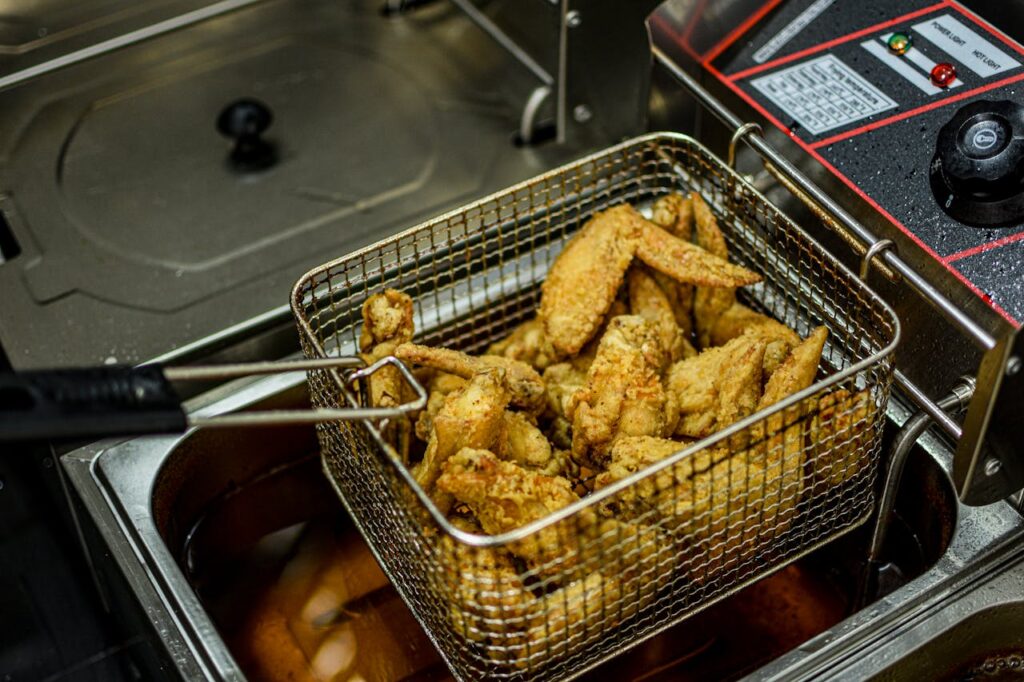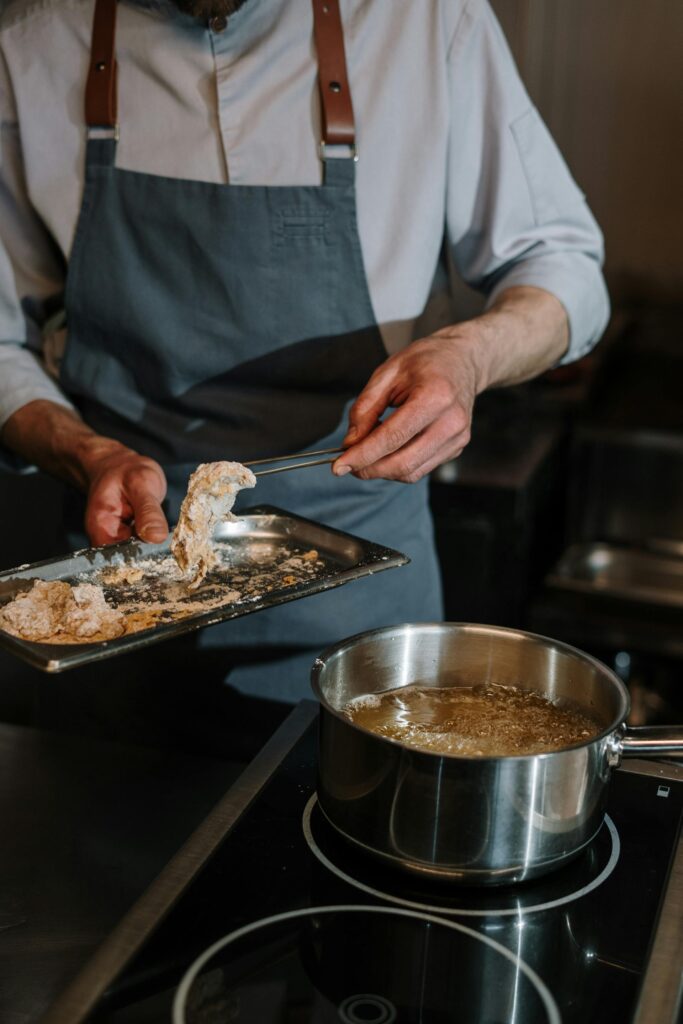7 Mistakes That Make You Waste Frying Oil (and How to Avoid Them)

Managing a commercial kitchen involves balancing quality, safety, and cost efficiency. One often-overlooked area that significantly affects profit margins is frying oil usage. Done correctly, you can save Fry-Oil costs in your UK restaurant while maintaining food quality and reducing waste. However, many operations unknowingly drain their resources by mishandling oil.
Continue reading to uncover the most common mistakes that lead to frying oil waste—and, more importantly, how to prevent them.
Mistake 1: Improper Temperature Management
Temperature abuse is a major driver of oil degradation. Many operations run fryers at unnecessarily high temperatures, mistakenly believing this improves efficiency.
When oil exceeds optimal cooking temperatures (typically 175-190°C), several harmful processes accelerate simultaneously:
- increased oxidation rates that create off-flavours
- faster polymerisation that darkens oil and increases viscosity
- more rapid breakdown of antioxidants that naturally protect the oil
Most built-in thermostats in commercial equipment deviate by 5-15°C. Instead of relying on that, verify fryer calibration weekly using an accurate digital thermometer. Additionally, implement temperature reduction protocols during periods of low activity. Maintaining full cooking temperatures during idle periods can significantly reduce oil life without providing any operational benefits.
Mistake 2: Neglecting Filtration Protocols
According to Restaurant Business Online, foreign matter poses one of the greatest threats to oil quality in commercial frying. As food is cooked, it releases particles that contaminate the oil, triggering a chain reaction of deterioration. These particles accelerate the breakdown of oil integrity, leading to higher smoke points, off-flavours, and decreased frying performance.
Poor oil quality also often results in soggy, greasy food rather than crisp, evenly fried products. Additionally, dirty oil leaves stubborn residue on fryer pots and heating elements, increasing cleaning time and maintenance costs.
Consistent filtration is essential for maintaining oil quality and extending usability. Removing food particles, carbon deposits, and breakdown compounds through systematic filtration prevents oil from degrading prematurely, ensuring consistent frying and improved cost efficiency.
Effective filtration practices include:
- filtering high-volume fryers after every 4-6 hours of continuous operation
- using appropriate filter media matched to your specific contaminant profile
- ensuring proper filtration temperature (typically 82-93°C) that balances flow characteristics with safety
- cleaning fryer walls and heating elements during the filtration process
Mistake 3: Poor Food Preparation Practices
How food items are prepared before they enter the fryer also impacts oil longevity. Excess moisture, loose breading, and high-starch content all accelerate degradation processes.
Before items enter your fryers, you should:
- thoroughly drain and pat dry moisture-rich items to minimise hydrolysis
- shake off excess breading or batter to reduce particulate accumulation
- allow frozen items to shed surface ice crystals or briefly thaw them
- avoid salting products before frying, as salt dramatically accelerates degradation

Mistake 4: Overloading Fryer Capacity
Overloading fryers during peak hours is a common practice aimed at increasing output, but it often leads to inefficiencies rather than improvements.
Excessive batch sizes lead to a significant drop in oil temperature, resulting in extended cooking times and altered oil composition. This delay affects operational speed and results in greasier food, increasing costs while compromising texture and flavour.
To maintain efficiency and product quality, adhere to standard batch sizes that are suited to your equipment. A product-to-oil ratio of approximately 1:6 by volume ensures proper heat transfer, minimises recovery time, and maintains consistent frying performance.
Mistake 5: Mixing Old and New Oil Indiscriminately
Adding fresh oil to degraded oil without systematic protocols accelerates the degradation of the new oil. Many operations randomly top up fryers rather than implementing strategic refreshment schedules.
Effective oil management requires thoughtful integration of fresh oil. To do that, filter the used oil to remove contaminants. Then, add consistent amounts of fresh oil rather than variable volumes. Ensure that each refreshment is documented to maintain quality accountability.
Mistake 6: Ignoring Oil Quality Testing
Subjective assessments (colour, smell, smoke) lead to inconsistent timing of replacement. Rather than relying on that approach, it’s best to use objective oil assessment approaches such as:
- Total Polar Compounds (TPC) measurement using digital meters
- Free Fatty Acid test strips for rapid assessment
- polymer content analysis for thermal degradation evaluation
TPC levels exceeding 20-25% indicate that frying oil is no longer suitable for use, as its viscosity, flavour, and nutritional value deteriorate significantly. Before oil reaches this threshold, replenishment or replacement is necessary to maintain food quality and consistency during frying.
Additionally, prolonged use, especially when frying starchy foods like potatoes, can lead to acrylamide buildup —a compound known to pose health risks. While acrylamide isn’t naturally present in fresh oil, its levels rise with repeated use.
Although there is no direct correlation between TPC levels and acrylamide concentration, research suggests that oils with high TPC values often contain elevated acrylamide levels. Hence, regular monitoring and timely oil replacement are essential to ensure food safety.
Mistake 7: Poor Fryer Maintenance Practices
Neglecting equipment maintenance compromises performance while accelerating oil degradation. Carbon buildup on heating elements reduces heat transfer efficiency while introducing contaminants that catalyse degradation.
You should establish comprehensive maintenance protocols that include:
- daily cleaning of fryer baskets and exterior surfaces
- weekly deep cleaning of fryer walls and elements
- monthly inspection of seals, controls, and safety systems
- quarterly professional maintenance for burners, gas lines, and electrical systems
Conclusion
Addressing these seven common mistakes transforms oil management from a significant cost burden to a strategic opportunity. While individual corrections provide incremental benefits, implementing comprehensive solutions typically reduces oil consumption while improving product quality and consistency. These improvements also lead to higher profitability, reduced environmental impact, and more efficient kitchen operations.
Frequently Asked Questions
1. How can I tell if oil is still safe to use if it looks fine?
Even if oil appears clear, it may still be chemically degraded. Sensory tests, such as smell, foam production, and taste, are more reliable than visual inspection alone. More importantly, doing objective measurements like the ones outlined above would deliver the most accurate results.
2. Are there any automated systems for managing fryer oil?
Many commercial fryers now come with built-in oil quality monitors, filtration systems, and auto-disposal features. These systems simplify oil management and reduce waste.
3. What’s the best storage method for used oil before disposal?
Used oil should be cooled and stored in a designated, sealed container. Containers must be labelled and kept in a well-ventilated area away from heat sources or direct sunlight.
4. Can I reuse oil from different fryers for the same type of food?
Combining oil from different fryers is not recommended unless both batches are in similar condition. Merging degraded oil with fresh oil can spoil the entire batch.
—
Header image source: https://www.pexels.com/photo/person-holding-knife-slicing-meat-4253709/





